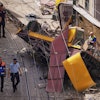
A severely burned Mississippi firefighter, who cunderwent the most extensive face transplant ever performed, is thriving one year after his historic surgery, according to his medical team at NYU Langone Medical Center. Among his many milestones, he has never had an incident in which his body has attempted to reject his new face - which is unprecedented amongst those who have had the procedure.
Patrick Hardison, 42, who was injured in the line of duty in 2001, has had several follow-up procedures since his transplant, principally to adjust his new eyelids and lips, and to remove the feeding tube from his abdomen and the breathing tube from his trachea. As a result, he has been able to return to activities he loves but had been unable to partake in since his accident, including driving a car and swimming.
"The surgery has truly given me back my life," says Hardison. "I go about my day just like everyone else. It's allowed me to do things with my family that I had not been able to do. I can't tell you what a sense of freedom it is to even drive my kids to school. We recently went on a family vacation to Disney World, and I swam in the pool with them - something I hadn't done in 15 years."
Hardison also adds: "There are no more stares, no more frightened children running away from me. I'm pretty much just a normal guy. Now, I want to help others to pursue this type of surgery, especially fellow firefighters and members of the armed services. There definitely is hope."
Photos of Patrick's progression can be found in the gallery on this page.
Detailing Medical Milestones
Eduardo D. Rodriguez, MD, DDS, the chair of the Department of Plastic Surgery at NYU Langone and the surgeon who led the team of over 100 medical professionals that performed Hardison's transplant, points to three significant milestones in his recovery: The absence of a rejection episode; the normal function of Hardison's new eyelids; and the execution and achievement of the most extensive soft tissue clinical face transplant to date.
Rodriguez also concludes that including selective facial bone structure in addition to the chin of the donor provided natural bone marrow stem cells to help the transplanted face thrive following the surgery, and provided the necessary positional support for the facial soft tissues.
The successful transplant of the donor's eyelids and blinking mechanisms also has been particularly important, as Hardison was in danger of losing his sight and had been unable to perform independent daily tasks. Blinking enables the body to appropriately hydrate and clean the eyes to prevent infection and preserve vision.
Now with fully functional eyelids, Rodriguez sees this particular aspect of Hardison's surgery as a "game changer" for the field of face transplantation. "Being able to give Pat this level of independence is a primary reason why we undertook this surgery," Rodriguez says.
Hardison's recovery has also allowed his medical team to move forward with the removal of his abdominal feeding tube and the breathing tube in his trachea much sooner in his recovery. In addition to removing the tubes, Rodriguez also has performed revisions to Hardison's forehead, eyes, lips, chin, and ears, now that the majority of the swelling has subsided
"Pat has been incredibly compliant with his post-surgical regimen, and that has allowed us to expedite his surgical schedule," Rodriguez notes. "He is extremely committed to daily exercise, taking his medications and meeting with his physicians regularly. All of this has put him way ahead of schedule in terms of getting to the optimal level of recovery and appearance."
What Lies Ahead
After a year of recovery, Hardison says he is ready to meet the family of his donor, David Rodebaugh, to thank them for their decision to donate his face, as well as other organs to other recipients. A meeting is planned for late fall.
To date, face transplants in the U.S. have been supported, at least in part, by research funding. The U.S. Department of Defense, in concert with transplant centers, is collaborating with insurance carriers to provide coverage for face transplantation. The Department of Defense also is working closely with Rodriguez and LiveOnNY to advance awareness around face transplants and the critical importance of organ donation.
"We have entered a new era in transplant surgery," Rodriguez points out. "The work being done, not only in face transplantation, but also in areas like hand, uterine and penile transplantation, is pushing the boundaries of medicine and surgery and opening up new avenues to restore the lives of people like Patrick. It's a very exciting time."






















